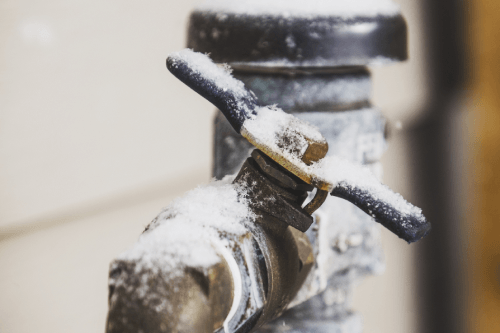In this article further down you might get lots of awesome content related to Helpful Tips to Prevent Frozen Pipes this Winter.
:strip_icc()/snow-outdoor-faucet-pipes-4af65d1e5e904fb1aa7bf74071fe5d89.jpg)
Cold weather can wreak havoc on your plumbing, particularly by freezing pipelines. Right here's exactly how to avoid it from occurring and what to do if it does.
Intro
As temperature levels decrease, the risk of icy pipelines boosts, potentially resulting in costly fixings and water damages. Understanding how to stop icy pipes is critical for house owners in cold environments.
Prevention Tips
Shielding susceptible pipelines
Cover pipes in insulation sleeves or make use of heat tape to protect them from freezing temperatures. Concentrate on pipelines in unheated or external locations of the home.
Home heating strategies
Maintain indoor spaces sufficiently heated up, specifically locations with pipes. Open up cupboard doors to enable warm air to distribute around pipes under sinks.
How to determine frozen pipes
Look for decreased water circulation from taps, uncommon odors or noises from pipelines, and noticeable frost on revealed pipelines.
Long-Term Solutions
Architectural changes
Consider rerouting pipelines away from exterior walls or unheated locations. Add extra insulation to attic rooms, cellars, and crawl spaces.
Updating insulation
Invest in top notch insulation for pipelines, attics, and walls. Proper insulation aids preserve consistent temperatures and lowers the risk of icy pipes.
Protecting Exterior Plumbing
Yard hoses and outside faucets
Separate and drain yard pipes before wintertime. Install frost-proof faucets or cover outdoor faucets with insulated caps.
Comprehending Icy Pipes
What creates pipelines to ice up?
Pipelines freeze when subjected to temperature levels below 32 ° F (0 ° C) for prolonged durations. As water inside the pipes freezes, it broadens, taxing the pipeline walls and potentially triggering them to break.
Threats and damages
Frozen pipelines can cause water disturbances, residential or commercial property damage, and expensive fixings. Ruptured pipes can flood homes and cause extensive architectural damage.
Indicators of Frozen Water Lines
Identifying icy pipes early can stop them from breaking.
What to Do If Your Pipelines Freeze
Immediate activities to take
If you think icy pipelines, keep taps open up to alleviate pressure as the ice melts. Utilize a hairdryer or towels soaked in hot water to thaw pipelines slowly.
Conclusion
Preventing icy pipes needs proactive actions and quick feedbacks. By comprehending the reasons, signs, and safety nets, property owners can secure their plumbing during winter.
Helpful Tips to Prevent Frozen Pipes this Winter
UNDERSTANDING THE BASICS: WHY PIPES FREEZE AND WHY IT’S A PROBLEM
Water freezing inside pipes is common during the winter months, but understanding why pipes freeze, and the potential problems it can cause is crucial in preventing such incidents. This section will delve into the basics of why pipes freeze and the associated problems that may arise.
THE SCIENCE BEHIND FROZEN PIPES
When water reaches freezing temperatures, it undergoes a physical transformation and solidifies into ice. This expansion of water as it freezes is the primary reason pipes can burst. As the water inside the pipe freezes, it expands, creating immense pressure on the walls. If the pressure becomes too great, the pipe can crack or rupture, leading to leaks and water damage.
FACTORS THAT CONTRIBUTE TO PIPE FREEZING
Low Temperatures: Extremely cold weather, especially below freezing, increases the risk of pipes freezing. Uninsulated or Poorly Insulated Pipes: Pipes located in unheated areas, such as basements, crawl spaces, or attics, are more prone to freezing. Insufficient insulation or lack of insulation altogether exacerbates the problem. Exterior Wall Exposure: Pipes running along exterior walls are susceptible to freezing as they encounter colder temperatures outside. Lack of Heating or Temperature Regulation: Inadequate heating or inconsistent temperature control in your home can contribute to frozen pipes. PROBLEMS CAUSED BY FROZEN PIPES
- Pipe Bursting: As mentioned earlier, the expansion of water as it freezes can cause pipes to burst, resulting in significant water damage.
- Water Damage: When pipes burst, it can lead to flooding and water damage to your property, including walls, ceilings, flooring, and personal belongings.
- Structural Damage: Prolonged exposure to water from burst pipes can compromise the structural integrity of your home, leading to costly repairs.
- Mold and Mildew Growth: Excess moisture from water damage can create a favorable environment for mold and mildew growth, posing health risks to occupants.
- Disrupted Water Supply: Frozen pipes can also result in a complete or partial loss of water supply until the issue is resolved.
WHY CERTAIN PIPES ARE MORE PRONE TO FREEZING
- Location: Pipes located in unheated or poorly insulated areas, such as basements, crawl spaces, attics, or exterior walls, are at higher risk of freezing.
- Exterior Pipes: Outdoor pipes, such as those used for irrigation or exposed plumbing, are particularly vulnerable to freezing as they are directly exposed to the elements.
- Supply Lines: Pipes that carry water from the main water supply into your home, including the main water line, are critical to protect as freezing in these lines can affect your entire plumbing system.
- Underground Pipes: Pipes buried underground, such as those connected to sprinkler systems or outdoor faucets, can be susceptible to freezing if not properly insulated.
https://busybusy.com/blog/helpful-tips-to-prevent-frozen-pipes-this-winter/

We had been shown that editorial about How to Prevent Your Pipes From Freezing from an acquaintance on another site. Enjoyed our article? Please quickly share it. Help other people check it out. Many thanks for your time spent reading it.
This Page